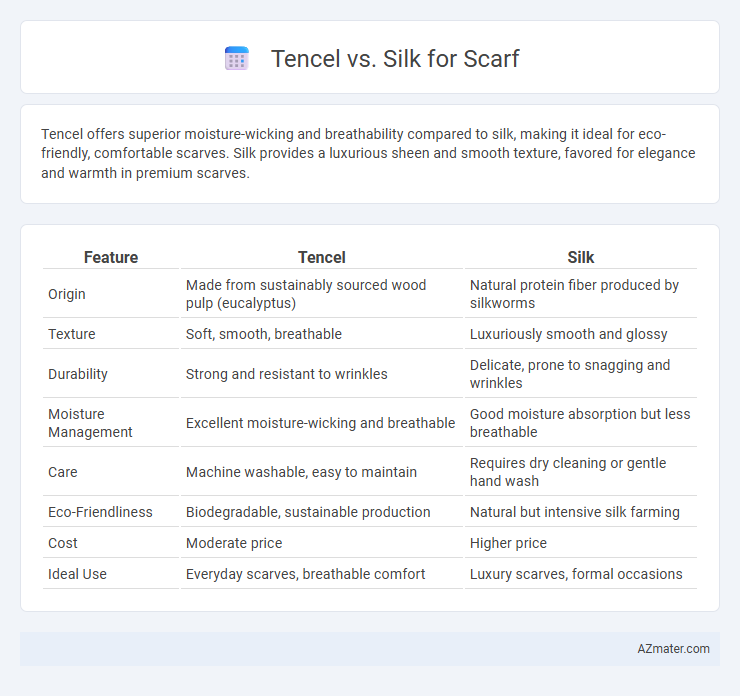Tencel offers superior moisture-wicking and breathability compared to silk, making it ideal for eco-friendly, comfortable scarves. Silk provides a luxurious sheen and smooth texture, favored for elegance and warmth in premium scarves.
Table of Comparison
| Feature | Tencel | Silk |
|---|---|---|
| Origin | Made from sustainably sourced wood pulp (eucalyptus) | Natural protein fiber produced by silkworms |
| Texture | Soft, smooth, breathable | Luxuriously smooth and glossy |
| Durability | Strong and resistant to wrinkles | Delicate, prone to snagging and wrinkles |
| Moisture Management | Excellent moisture-wicking and breathable | Good moisture absorption but less breathable |
| Care | Machine washable, easy to maintain | Requires dry cleaning or gentle hand wash |
| Eco-Friendliness | Biodegradable, sustainable production | Natural but intensive silk farming |
| Cost | Moderate price | Higher price |
| Ideal Use | Everyday scarves, breathable comfort | Luxury scarves, formal occasions |
Tencel vs Silk for Scarves: A Quick Overview
Tencel scarves offer superior moisture-wicking properties and breathability compared to silk, making them ideal for sensitive skin and hot climates. Silk scarves feature a luxurious sheen and smooth texture but require more delicate care and can be less durable under frequent use. Choosing between Tencel and silk depends on preferences for sustainability, maintenance, and fabric performance in scarf applications.
What is Tencel? Key Properties Explained
Tencel, a branded lyocell fiber, is produced from sustainably sourced eucalyptus wood pulp through an environmentally friendly process that recycles water and solvents. Key properties include exceptional softness, breathability, moisture-wicking abilities, and biodegradability, making it ideal for scarves that offer comfort and eco-consciousness. Compared to silk, Tencel provides enhanced durability and wrinkle resistance while maintaining a smooth, luxurious feel.
Understanding Silk: Features and Benefits
Silk is a natural protein fiber known for its luxurious softness, smooth texture, and excellent breathability, making it highly comfortable for scarves. Its hypoallergenic properties and moisture-wicking ability help regulate temperature, providing warmth in cooler weather and coolness in warmer conditions. Silk scarves also boast a natural sheen and vibrant color retention, enhancing their aesthetic appeal and durability over time.
Comfort and Breathability Compared
Tencel scarves offer superior breathability and moisture-wicking properties, making them ideal for maintaining comfort in warm and humid conditions. Silk scarves provide a smooth, luxurious feel with natural temperature-regulating abilities but tend to retain more heat and moisture compared to Tencel. For long-lasting comfort and enhanced airflow, Tencel is the preferred choice over silk in scarf materials.
Durability and Longevity: Which Lasts Longer?
Tencel scarves outperform silk in durability due to the fiber's high tensile strength and resistance to wear and tear, making them less prone to pilling and fraying over time. Silk, while luxurious and soft, is more delicate and susceptible to damage from moisture, sunlight, and friction, which can shorten its lifespan. For long-lasting scarves, Tencel offers greater longevity and maintains its quality through repeated use and washes compared to silk.
Sustainability and Eco-Friendliness
Tencel scarves boast superior sustainability due to their production from sustainably sourced eucalyptus wood using a closed-loop process that recycles water and solvents, minimizing environmental impact. Silk, derived from silkworm cocoons, involves intensive water and pesticide use, along with ethical concerns related to sericulture, making it less eco-friendly compared to Tencel. Choosing Tencel supports reduced carbon emissions and biodegradable fabric qualities, aligning with environmentally conscious fashion preferences.
Ease of Care and Maintenance
Tencel scarves are favored for their low-maintenance care, as they are machine washable and resistant to wrinkles, making them perfect for everyday use. Silk scarves require delicate hand washing or dry cleaning to maintain their luxurious texture and sheen, demanding more careful handling. The durability of Tencel also helps retain color and shape after multiple washes, while silk's natural fibers can be prone to water spots and damage if not properly cared for.
Style, Drape, and Aesthetic Appeal
Tencel scarves offer a sleek, smooth drape with a subtle sheen that enhances modern, minimalist style while providing excellent breathability and durability. Silk scarves, renowned for their luxurious texture and natural sheen, drape fluidly with a soft, elegant flow, ideal for adding classic sophistication and vibrant color richness to outfits. Both fabrics elevate aesthetic appeal, with Tencel favoring contemporary, eco-friendly fashion and silk embodying timeless luxury and refined glamour.
Price Comparison: Tencel vs Silk Scarves
Tencel scarves typically cost between $20 and $50, offering an affordable yet sustainable alternative to silk scarves, which range from $50 to $200 or more depending on quality and brand. The price difference reflects the production processes, with silk requiring labor-intensive sericulture and Tencel being made from sustainably sourced wood pulp using eco-friendly methods. Consumers seeking cost-effective, durable, and eco-conscious options often choose Tencel, while silk remains a premium choice prized for its luxury and natural sheen.
Choosing the Right Scarf: Which Material Is Best for You?
Tencel scarves offer exceptional breathability, moisture-wicking properties, and durability, making them ideal for sensitive skin and everyday wear. Silk scarves stand out for their luxurious texture, natural sheen, and excellent temperature regulation, providing a sophisticated and elegant look. Choosing between Tencel and silk depends on your priority for comfort and sustainability versus luxury and classic style.

Infographic: Tencel vs Silk for Scarf
 azmater.com
azmater.com